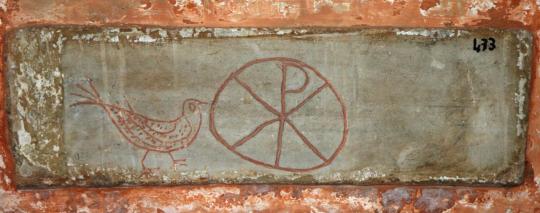#Christogram
Text

Y’all want straightedge Jesus symbolism? I’ll give you straightedge Jesus symbolism.
#I love Christograms bro#and this looks dope if I do say so myself#it’s no Black Flag but it’s pretty sweet#once again WWE merch department can’t hold my nuts#cm punk#my edit
17 notes
·
View notes
Text

Gilded silver Communion paten with Christogram, Byzantine, 6th century AD
from Dumbarton Oaks
380 notes
·
View notes
Text

A fine polychrome silk and metal-thread embroidered chalice veil, European, possibly English, first half 17th century
worked in polychrome silks and metal-threads with an IHS Christogram with cross in the centre within a golden glory (circle of rays to surround and show a holy symbol or object) figure of Christ below holding an earth-like orb with the inscription 'Salvator Mundi', the ground powdered with satin-stitched motifs of 'Instruments of the Passion' (Arma Christi), and sprinkled with spangles and embroidered stars, the four-sided border depicting scrolls of foliate and naturalistic flowers, cherub heads and raised silver-thread foliate scrolls, on an ivory satin ground.
Sotheby’s
93 notes
·
View notes
Text

THE DESCRIPTION OF THE HOLY NAME OF JESUS
The Name Above All Names
Feast Day: January 3
"Praised be Jesus Christ!" -Enchiridion Indulgentiarum
In connection with the circumcision and the naming of the Holy Child on the first of January, the Catholic faithful celebrate the feast of the Holy Name of Jesus.
Jesus is a Hebrew name which means, 'God Saves.'
In the Gospel of Luke, the archangel Gabriel revealed the holy name to Mary, when he announced: 'You will conceive in your womb and bear a son, and you shall name him Jesus.'
In the Acts of the Apostles, in order to be saved, we must believe in the name of Jesus, as the apostle Peter said: 'There is no other name under heaven given to men by which we must be saved.'
For this reason, all liturgical prayers conclude with the words: 'Through Our Lord Jesus Christ.'
Perhaps the greatest promoter of the Holy Name of Jesus was St. Bernardine of Siena, who coined the Latin Christogram, 'IHS', which stands for Iesus Hominum Salvator, which means 'Jesus, savior of men.'
At the end of his sermons, he usually displayed the IHS on a tablet in gold letters, and would ask the faithful to kneel in adoration. The devotion to the Holy Name became so popular, that the IHS was inscribed in churches, sacred vestments, and on the Eucharistic bread.
7 notes
·
View notes
Text
A researcher made a serendipitous discovery in Ghazali, Sudan when she stumbled upon a unique Christogram tattoo etched on a 1,300-year old body. What hidden secrets of Nubia's heritage and faith will this ancient tattoo reveal?
14 notes
·
View notes
Note
Impulsively sharing my favorite goofy, barely any differences late antiquity ancient Roman AU: AU but the only difference is that Constantine I saw the fish Christogram in the "In this sign conquer" dream and instead of the labarum & the chi-rho, late antiquity is just covered in Jesus fish
Oh. Yeah. This is the stuff.
Another possibility: Constantine sees this symbol:
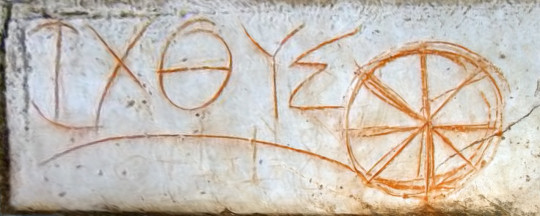
The eight-spoked wheel can evoke all the Greek letters of ichthys (“fish”) overlaid atop one another. However, it’s also a prominent symbol of Buddhism’s eightfold path. Imagine the dialogues where Christian preachers and Buddhist monks try to convince Constantine which one it is
29 notes
·
View notes
Photo


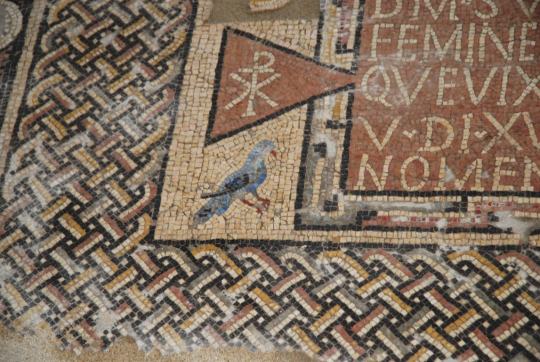

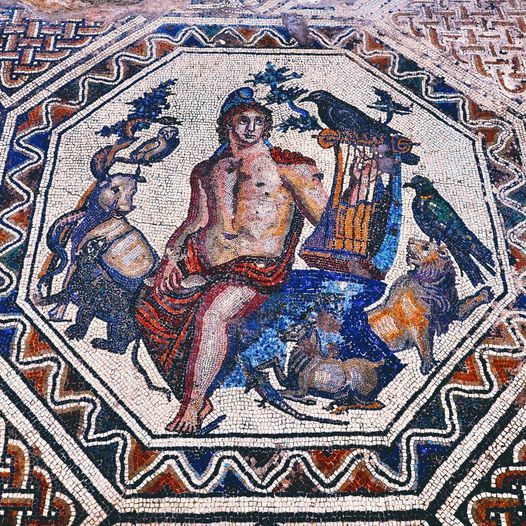

4th Century Roman Couple’s Funerary Mosaic Restored
A funerary mosaic dedicated to a Roman couple of late Antiquity is returning to its museum home in Porto Torres, Sardegna, after more than a year of restoration.
The mosaic was discovered in 1964 when road construction unearthed a complex of 11 Late Roman burials. Most of them were in rock-cut graves covered with terracotta roof tools arranged either flat or in the cappucina style, ie, tilted against each other to form a pitched roof. Eight of the burials were closely grouped together in a confined space, including the burials of two individuals whose matching pitched-roof tombs were adjacent to each other. A polychrome mosaic inscription identified the deceased as married couple Dionisio and Septimia Musa.
The osteological remains were in poor condition and had been disturbed over the centuries. There were no grave goods to aid in dating, but the cappucina style was very widespread in the popular in the Late Roman Imperial era. Funerary mosaics comparable in style to Dionisio and Septimia Musa’s, found most often in Northern Africa, and the language of the dedication narrow down the date of the tombs to the second half of the 4th century or to the early 5th.
The mosaic featured two inscriptions of cream tiles against a rectangular field of red tiles to give the impression of an engraved plaque. Septimia Musa’s inscription is above her husbands. It records that she lived 47 years. Dionisio’s inscription includes the dedication from their “loving children.” Hers is bordered in a 3D gemetric rectangle. His is bordered in guilloche shapes. A more intricately enlaced guilloche pattern covers the background behind the plaques. The outer borders feature a curling ribbon pattern.
The mosaic is rich in Christian iconography. Both plaques have triangular faux mounts on each side featuring the Christogram. Septimia Musa’s inscription has another Christogram in the RIP text at the end, as well as an olive branch. Olive branches are above and doves beneath the Christograms in the left and right triangles.
The mosaic was lifted, conserved and put on display at the Antiquarium Turritano Porto Torres, the local museum dedicated to the material culture of the colony of Roman Turris Libisonis and the surrounding territory. In the six decades since, the mosaic tiles have begun to suffer from adherence problems. It was removed from display in September 2020 and conservators worked to stabilize and clean it until March of this year.
The museum will be closed on Tuesday to ensure the transfer and reinstallation of the mosaics goes as smoothly as possible. The mosaic will have to be reassembled, positioned and fixed securely in its dedicated gallery at the Antiquarium Turritano before the museum reopens to the public on Wednesday.
#4th Century Roman Couple’s Funerary Mosaic Restored#roman mosaic#ancient artifacts#archeology#archeolgst#history#history news#ancient history#ancient culture#ancient civilizations#ancient tomb#ancient grave#late roman burial#roman history#roman empire
50 notes
·
View notes
Text

"Jesus to me is honey in the mouth, music in the ear, a song in the heart." - #SaintBernardofClairvaux
📷 IHS Christogram in the Church of Il Gesù, Rome / #LawrenceOP / #Flickr (CC BY-NC-ND 2.0). #MostHolyNameofJesus #Catholic_Priest #CatholicPriestMedia
11 notes
·
View notes
Text
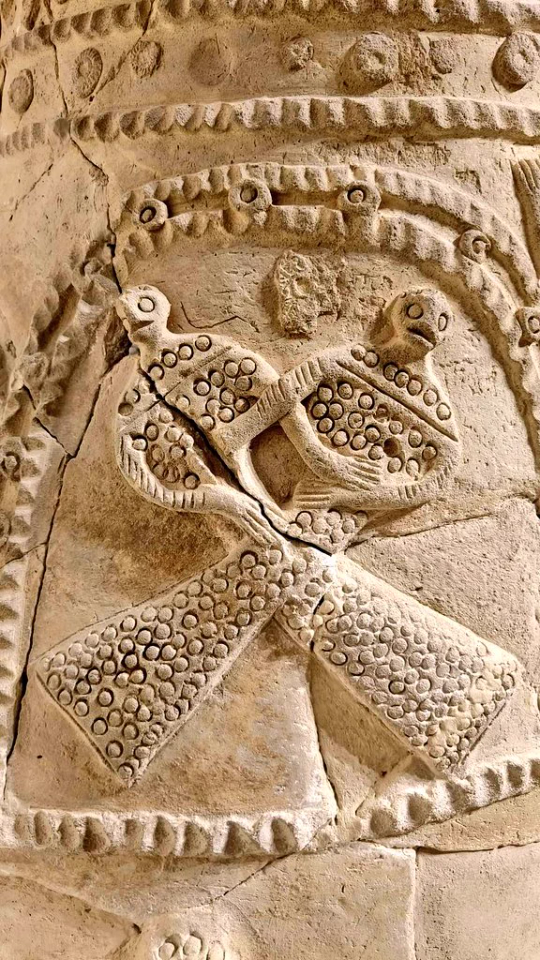
Iraqi National Museum, pottery detail 3rd century AH (which corresponds to 9th century CE).
I'm fascinated by rebis images in alchemy--a male and a female figure sharing a single body. This is probably not a rebis; someone suggested it might be a Christogram, given the time period. But I love the way the arms are placed and the lower parts of the bodies are crossed. Gender is not apparent to me.
2 notes
·
View notes
Text
Ok so in Kingdom Hearts, there's this ultimate weapon called the x-blade, like the Greek letter X so it's pronounced keyblade still it's kind of a funny little joke. It's one of the most important items in the entire series because it's meant to open Kingdom Hearts or something I don't remember something like that. What I do know is that X in the original Greek language is a Christogram, which means it's a short way of saying Christ, which means the x-blade is the Jesus Sword and Mickey Mouse NEEDS it
#kingdom hearts#language#remember when goofy fucking died that was pretty funny#i cannot wait for moses to show up in kingdom hearts 4
4 notes
·
View notes
Text
(gently cups your face between my hands) hey. hey. before you write "merry xmas" in your merch as an attempt to force christmas as a "secular" holiday onto non-christians, or god forbid, before you are a christian getting offended by "merry xmas" and it "censoring Christ's name", please consider (squeezes your face) it's literally a christogram. the "x" is a "chi". the first letter in the word "Χριστός". the "x" is "Christ". stop
5 notes
·
View notes
Text
The Exorcistic Significance of the St. Benedict Medal and the Enhanced Relijewels Medal
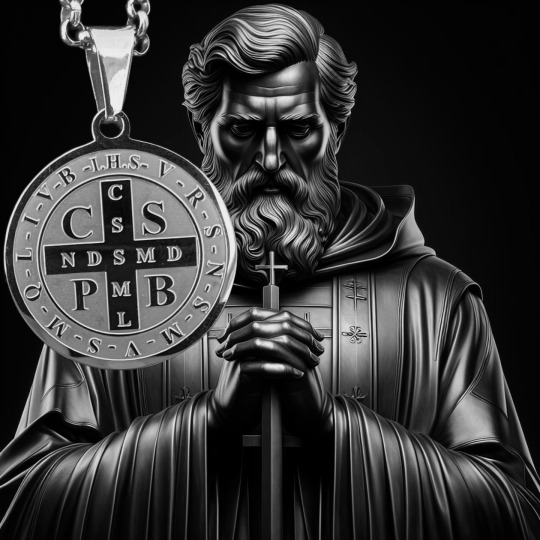
The **St. Benedict Medal** holds a significant place in the realm of spiritual warfare. It is a symbol of protection against demonic influences, embodying the power of faith as a shield against negativity and evil in all its forms.
The Power of the St. Benedict Medal
The St. Benedict Medal is renowned for its exorcistic properties. It is believed to provide protection against evil spirits and the forces of darkness. The medal carries the image of St. Benedict, who was a beacon of light in the dark ages, his life a testament to the power of faith over evil.
The reverse side of the medal carries significant inscriptions, including the initials of Latin phrases that translate to powerful prayers of exorcism. These inscriptions serve as a constant reminder of God's protection and the power of prayer.
The Enhanced Relijewels Medal
The **Relijewels Medal** takes the protective and exorcistic properties of the St. Benedict Medal to another level. This ancient medal is enhanced by the **IHS**, a Christogram representing the Holy Name of Jesus. This potent combination makes the Relijewels Medal a formidable tool against the devil and malevolent forces.
The IHS enhancement amplifies the medal's power, making it a potent symbol of faith and a shield against negativity. It serves as a constant reminder of the protective power of faith and the presence of divine assistance in the face of evil.
A Shield Against Negativity
Both the St. Benedict Medal and the enhanced Relijewels Medal serve as shields against negativity. They are not just pieces of metal but symbols of faith that carry with them a promise of divine protection. They stand as bulwarks against the malign in every form, be it fear, doubt, despair, or the forces of evil.
In conclusion, the St. Benedict Medal and the enhanced Relijewels Medal are more than just religious artifacts. They are powerful symbols of faith and divine protection, serving as constant reminders of the power of good over evil. They embody the belief that with faith, we can overcome any form of negativity or malign influence. They are indeed powerful tools in the spiritual warfare that each of us faces in our daily lives.
Go to site: www.relijewels.it
0 notes
Text
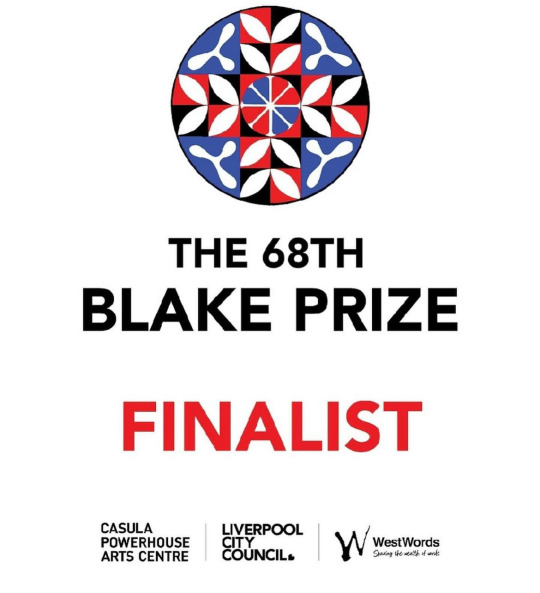


I’m honoured to have been selected as a finalist in The Blake Prize, 2024.
The Blake Prize prompts artists to explore the vast realms spirituality and religion, usually with incredibly personal, introspective results.
At least it was for me!
The 68th Blake Prize exhibition will be on display at Casula Powerhouse Arts Centre from 11 May to 7 July 2024.
Exhibition launch: Saturday 18 May 2024, 2-4pm.
Title of work: Sacred Botanical
About the painting:
One’s spiritual / religious lineage is a fundamental link to our past. The vast devotional body of work, ephemeral and extant, that our ancestors investigated, explored and gifted us, exists in the hope that we would, in times of conflict be held secure in belonging & community.
This work, Sacred Botanical, is an exploration of my spiritual lineage. Depicted throughout this work are the sacred plants of the Bible, along with plants sacred to the Druids and early Celtic Christians.
The botanical plants, in their lacing and intertwining on the canvas, are designed to form the ghosted image of the Chi-Rho (☧)- one of the oldest known Christograms.
The botanical plants depicted, sacred to the Druids and early Celtic Christians, are the Yew, Ivy, Oak & Mistletoe.
The sacred plants depicted from the Bible are the Anemone, Rose, Madonna lily, Grape & Iris.
Each plant had its own sacred meaning and use to the ancestors.
The olive branch has come to be understood as a universal symbol of peace (ancient Greek), and was added, as the painting evolved, as a fervent wish for peace in this time of current conflict.
#figurative art#realism painting#traditional art#realism#figurative painting#australian artist#oil painting#keep going#perserverance#sacred art
0 notes
Text
It's weird how at the end of page 168 of Geosophia Volume II Jake Stratton Kent refers to the Greek ΙΗΣ as a mystic formula representing Dionysus, but if you look for it you find that's literally the Christogram, formed from the first three letters of the name Iesous, or Jesus.
0 notes
